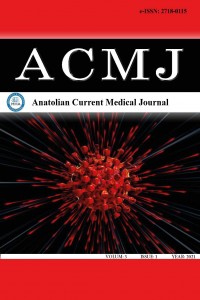Abstract
References
- 1. Novel coronavirus (2019-nCoV) situation reports. Available from: https://www.who.int/emergencies/diseases/novel-coronavirus-2019/situation-reports.
- 2. Ai T, Yang Z, Hou H, et al. Correlation of chest CT and RT-PCR testing for coronavirus disease 2019 (COVID-19) in China: a report of 1014 cases. Radiology 2020; 296: E32-E40. doi:10.1148/radiol.2020200642.
- 3. Chung M, Bernheim A, Mei X, et al. CT imaging features of 2019 novel coronavirus (2019-nCoV). Radiology 2020; 295: 202-7.
- 4. Song F, Shi N, Shan F, et al. Emerging 2019 novel coronavirus (2019-nCoV) Pneumonia. Radiology. 2020; 295: 210-7.
- 5. Kashiwabara K, Kohshi S. Additional computed tomography scans in the prone position to distinguish early interstitial lung disease from dependent density on helical computed tomography screening patient characteristics. Respirology 2006; 11: 482-7.
Revealing the dilemma in COVID-19 pneumonia: use of the prone thorax CT imaging in differentiation of opacificities due to dependant zone and pneumonic consolidation.
Abstract
In December 2019, a disease called Coronavirus disease 2019 (COVID-19) caused by the novel coronavirus called severe acute respiratory syndrome coronavirus 2 (SARS- COV-2) emerged in Wuhan, China. The disease was declared as a pandemic by the WHO on May 11, 2020. The gold standard to diagnose is a Real-time reverse transcriptase-polymerase chain reaction (RT-PCR) test. Additionally, computed tomography (CT) is also very useful in certain cases.
A 62-year-old female patient was admitted to the emergency room with fever and joint pain for five days. She had a history of contact with COVID- 19 (+) patient. Unenhanced lung CT performed in the prone position clearly showed nodular infiltrations in the subpleural/peripheral lower lung areas in the right lung. Another 73-year-old female patient was admitted to the emergency room with tiredness and loss of taste for a few days. She had no history of contact with COVID-19 (+) patients. Unenhanced lung CT performed while the patient was in supine position, diffuse nodular opacities in the lower regions of both lungs could hardly be detected. The combined throat nose swab test was positive in both patients. In conclusion, lung CT in prone position is a very valuable method of imaging to show COVID-19 pneumonia; it can distinguish true COVID-19 pneumonia from dependent lung zones in the supine position.
References
- 1. Novel coronavirus (2019-nCoV) situation reports. Available from: https://www.who.int/emergencies/diseases/novel-coronavirus-2019/situation-reports.
- 2. Ai T, Yang Z, Hou H, et al. Correlation of chest CT and RT-PCR testing for coronavirus disease 2019 (COVID-19) in China: a report of 1014 cases. Radiology 2020; 296: E32-E40. doi:10.1148/radiol.2020200642.
- 3. Chung M, Bernheim A, Mei X, et al. CT imaging features of 2019 novel coronavirus (2019-nCoV). Radiology 2020; 295: 202-7.
- 4. Song F, Shi N, Shan F, et al. Emerging 2019 novel coronavirus (2019-nCoV) Pneumonia. Radiology. 2020; 295: 210-7.
- 5. Kashiwabara K, Kohshi S. Additional computed tomography scans in the prone position to distinguish early interstitial lung disease from dependent density on helical computed tomography screening patient characteristics. Respirology 2006; 11: 482-7.
Details
| Primary Language | English |
|---|---|
| Subjects | Health Care Administration |
| Journal Section | Case Report |
| Authors | |
| Publication Date | January 22, 2021 |
| Published in Issue | Year 2021 Volume: 3 Issue: 1 |
Cited By
Medical device related pressure injuries in COVID-19 patients followed up in an intensive care unit
Journal of Health Sciences and Medicine
https://doi.org/10.32322/jhsm.1011537
TR DİZİN ULAKBİM and International Indexes (1b)
Interuniversity Board (UAK) Equivalency: Article published in Ulakbim TR Index journal [10 POINTS], and Article published in other (excuding 1a, b, c) international indexed journal (1d) [5 POINTS]
Note: Our journal is not WOS indexed and therefore is not classified as Q.
You can download Council of Higher Education (CoHG) [Yüksek Öğretim Kurumu (YÖK)] Criteria) decisions about predatory/questionable journals and the author's clarification text and journal charge policy from your browser. https://dergipark.org.tr/tr/journal/3449/file/4924/show
Journal Indexes and Platforms:
TR Dizin ULAKBİM, Google Scholar, Crossref, Worldcat (OCLC), DRJI, EuroPub, OpenAIRE, Turkiye Citation Index, Turk Medline, ROAD, ICI World of Journal's, Index Copernicus, ASOS Index, General Impact Factor, Scilit.The indexes of the journal's are;
The platforms of the journal's are;
| ||
|
The indexes/platforms of the journal are;
TR Dizin Ulakbim, Crossref (DOI), Google Scholar, EuroPub, Directory of Research Journal İndexing (DRJI), Worldcat (OCLC), OpenAIRE, ASOS Index, ROAD, Turkiye Citation Index, ICI World of Journal's, Index Copernicus, Turk Medline, General Impact Factor, Scilit
EBSCO, DOAJ, OAJI is under evaluation.
Journal articles are evaluated as "Double-Blind Peer Review"














